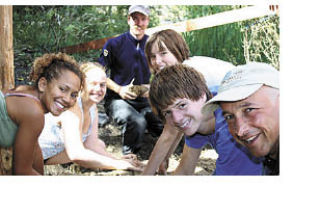As part of the Farm Education and Sustainability for Teens (FEAST) program, students have been learning about and building a shed kiosk and bench at The Funhouse, using a variety of natural and sustainable building techniques. To complete the project a number of Orcas Island community members have been donating their time, expertise and resources to the project.
According to project coordinators Owen Cheevers and Rusty Evans, at the homestead of Eric and Amy Lums the class learned to split wood and to peal the four cedar posts, from wood donated by the Lum family, to be used in the natural building project. “Eric Lum demonstrated how his Lucas sawmill worked while milling all of the wood used in the project. Rankin led a daylong carpentry and building workshop, which taught how to cut rafters, place posts and raise the beams for the structure above the bench using only hand tools. Mathew Maher of the Green Horizon Project also contributed his time and tools. Errol and Kathleen Speed invited the students to tour their store and shared their knowledge of natural building and hand tools. In a later stage of the project, Olga Valley Builders’ Paul Groeninger will help the students install the metal roofing using supplies he is donating. Sam Bullock designed and installed a Permaculture garden that surrounds The Funhouse building with a miniature wetland space ideally located to benefit from water run-off from the shed roof,” said Cheevers.
The bench construction process began according to FEAST staff with rock donated by Savvy Sanders. Salvaged concrete from a building demolition called “urbanite” was also fitted together by the students to form the foundation of the bench. The next layer was to manufacture cob.
“All the materials we are using for the project are readily available on Orcas. The cob was formed using clay, sand and straw. Sarah Ross of Tap Root Farm in Doe Bay contributed the clay dirt. To form the cob students had to stomp on the mixture, form it into balls and pack and mold it on to the fitted rock foundation,” Cheevers said.
According to FEAST organizers the entire project will take a little over two weeks to complete with students working on Tuesday, Aug. 12 from 9 to 2 p.m. to apply a natural plaster to finish the project.
“We recognized that we could have simply found a decorative piece of driftwood and placed it at the Funhouse and called it a bench. However, as we have repeated in a funny Winston Churchill accent so often throughout the project ‘this is much more than just a bench! This is community building project … building community.’ It’s a bench for the people of Orcas Island made by the people of Orcas Island,” Cheevers says of how they all feel about the project.
He says that when the bench and kiosk are completed an informational Kiosk will hang above the bench that will help visitors see the “spaceship of sustainability” that Pete Moe, The Funhouse Executive Director, says The Funhouse is becoming.
“The Funhouse has hosted multiple FEAST events and workshops, helping tremendously… it is a true pleasure to be able to honor their vision with the addition of this bench and kiosk,” FEAST Coordinator Whitney Hartzell explained.
Staff invites the public to come to The Funhouse to learn about natural plastering on Aug. 12 and to ask the FEAST students about all that they are learning this summer.



